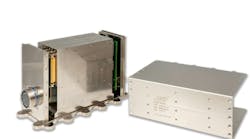Officials of the Air Force Research Laboratory (AFRL) at Kirtland Air Force Base, N.M., released a broad agency announcement Tuesday (BAA-RVKD-2014-0003) for the High-Powered Electromagnetics (HPEM) Research Program.
Photo by B.E. Meyers & Co. (www.bemeyers.com)
This initiative seeks to develop HPEM technology not only for directed-energy weapons, but also for cyber warfare, electronic warfare (EW), electronics-killing weapons, power electronics, and antennas.
The program, sponsored by the High-Powered Electromagnetics Division of the AFRL Directed Energy Directorate at Kirtland Air Force Base, will be open for five years and will be worth about $140 million over that period.
It has six technical areas, and Air Force researchers say they plan to award one contract for each of the six technical areas, which are: HPEM Transition; HPEM Cyber/Electronic Warfare (EW) Applications; HPEM Effects; Electromagnetics (EM) Weapons Technology; Numerical Simulation; and NextGen HPEM. Air Force experts will release separate solicitations for each technical area.
HPEM Transition will develop concepts for HPEM systems, components, and information, including the feasibility of integration and development of HPEM technology into a platform.
HPEM Cyber/Electronic Warfare (EW) Applications will identify and develop HPEM technologies for the cyber and electronic warfare communities.
HPEM Effects will investigate the effects of HPEM against a broad range of electronics, and develop predictive models for HPEM battle damage.
Electromagnetics (EM) Weapons Technology will move new HPEM technologies into pulsed-power weapons, including developing compact repetitive pulsed-power topologies; investigating high-energy particle beams; and creating weak and strongly ionized plasmas using ultrashort pulse lasers (USPL).
Related: Air Force tells industry to prepare for upcoming RF and electro-optical research program
Numerical Simulation will develop simulation to help develop modern HPEM systems and the Improved Concurrent Electromagnetic Particle-in-Cell (ICEPIC) software.
NextGen HPEM will develop the source and antenna technologies for HPEM weapons, including broadband high power amplifiers, tunable high power oscillators, and broadband antennas RF effects weapons that work over a broad range of frequencies, pulse lengths, pulse repetition frequencies, and power densities.
Proposal due dates and times will be specified in each new call. For technical questions or concerns contact the Air Force's Tyrone Tran by phone at 505-846-0299, or by email at [email protected]. For contracting questions or concerns contact Katy Florez by phone at 505-846-2037, or by email at [email protected].
More information is online at https://www.fbo.gov/spg/USAF/AFMC/AFRLPLDED/BAA-RVKD-2014-0003/listing.html.



